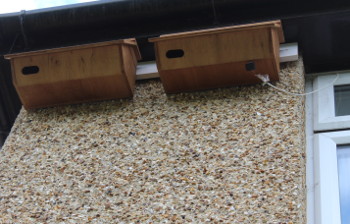
Swift boxes under our eaves with tiny loudspeaker attached
I am very fond of swifts. Apus apus, that torpedo like aerial master that appears here in the UK during early May and is gone by mid-August. Alongside their cousins the swallows (RAF chaps of 1940s vintage with huge moustaches) and martins (pleasure fliers – talented yet amateur), swifts are NASA pilots, destined for special and highly secret missions. Which may explain what they do for the eight months we don’t see them.
In the summer of 2016, our friend Bob gave us several swift nest boxes. Bob is an enthusiastic birder. No he’s more than that. He appears to live and breathe birds and whilst he works as a Countryside Ranger, in his spare time he carries out commercial bird and bat counts. The money from these bits of work he uses to buy stuff for the likes of me to encourage wildlife. And that was swift boxes; together with two small amplifiers and a couple of timers. I’d said I would be happy to attach swift nest boxes to our house and sometime later said boxes were delivered. It was however, a bit late in 2016 so it wasn’t until April 2017 that I actually got the boxes up. No mean feat for someone like myself who does not relish working at the top of a ladder, with a drill, under the eaves of a two-storey house.
In the end, I put two boxes on my mother in law’s house at the other end of the village as space was limited in a suitably sheltered location on ours. With the boxes firmly attached, my next task was attaching a tiny loudspeaker to one of the boxes and wiring this to the amplifier then plugging that into the mains via the timer. The result – boxes ready to be occupied, with the cries of swifts played from 4.30 to 7.30am and again from 6.30 to 9pm, every day until mid-August. In theory, adults casing the village for potential nest sites would be attracted to the new boxes and might take the time to visit.
Swifts like to nest in crevices in walls and spaces under roofs that are fairly high up – 4 metres plus, sheltered from prevailing winds and constant sunshine. Such spaces are harder to find now than previously, particularly in buildings as we become fussier about leaving holes under the eaves of new houses.
On 1st May this year I was excited to see a huge congregation of swifts – perhaps sixty strong, in Ampthill, about eight miles west of us, circulating over a piece of scrubby woodland next to Ampthill Rugby Club. I guessed they were feeding before continuing their journey north. Rather buoyed by this sight, I returned home hoping to see swifts newly arrived in Gravenhurst. Although over the next few days I did see a handful wheeling around the sky every so often, numbers seem to have been very low this year.
I fear our lovely new nest boxes may have been a year too late. Time will tell. Bob told us right from the start that swift wisdom suggests that this is a two-year effort. In the first, birds cruise for nest sites and remember likely ones for an immediate start the following spring. I suppose for a bird whose visit is so brief, knowing where they will nest before arrival must be a great advantage. Now in the second week of August 2017, I have not seen a swift for a couple of weeks and had accepted they had gone until this morning when we bumped into the owner of Gravenhurst’s ‘swift house’ – where a good population sets up shop each May. They nest in the roof space and can be seen flashing around the vicinity of a July evening. They told us there were still unfledged chicks in residence (they could hear them whistling through their ceiling) and that they won’t leave until those have flown. It has to be imminent though and it’s always a notable point in the year; a peak over the horizon to winter. I will shortly remove the speakers from the boxes and store them safely. The boxes I’ll leave in place, ready for action (hopefully) in 2018.
I’ve missed our swifts this year and have been envious when visiting neighbouring villages whose swifts appear to be very much present and hopefully correct.
